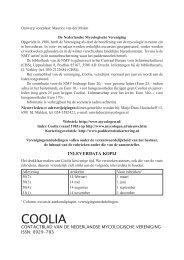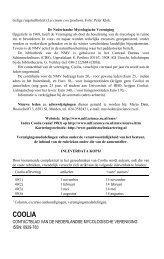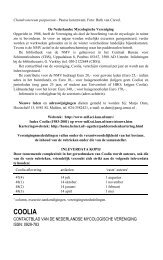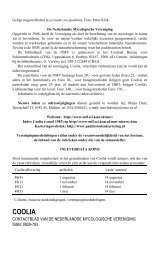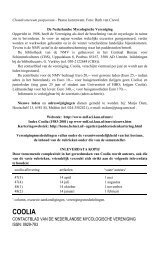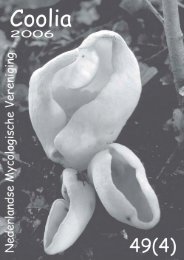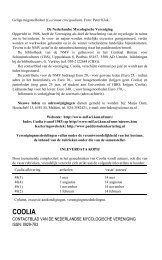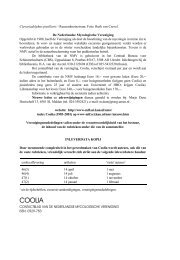Coolia 47(4) - Nederlandse Mycologische Vereniging
Coolia 47(4) - Nederlandse Mycologische Vereniging
Coolia 47(4) - Nederlandse Mycologische Vereniging
Create successful ePaper yourself
Turn your PDF publications into a flip-book with our unique Google optimized e-Paper software.
koolstofvoorziening door de mycorrhizaschimmels verzorgd (of liever via de schimmel aan<br />
een boom onttrokken), maar ook blijkt de stikstofvoorziening tussen de 50 en 100% via de<br />
schimmel te verlopen.<br />
Literatuur<br />
Allen, T.R., Millar, T., Berch, S.M. & Berbee, M.L. 2003. Culturing and direct DNA extraction find<br />
different fungi from the same ericoid mycorrhizal roots. New Phytologist 160: 255-272.<br />
Cameron, K.M., Chase, M.W., Whitten, W.M., Kores, P.J., Jarrell, D.C., Albert, V.A., Yukawa, T.,<br />
Hills, H.G. & Goldman, D.H. 1999. A phylogenetic analysis of the Orchidaceae: evidence from<br />
rbcL nucleotide sequences. American Journal of Botany 86: 208-224.<br />
Gebauer, G. & Meyer, M. 2003. 15 N and 13 C natural abundance of autotrophic and mycoheterotrophic<br />
orchids provides insight into nitrogen and carbon gain from fungal association. New Phytologist<br />
160: 209-223.<br />
Girlanda, M., Fabbian, R., Cafasso, D., Selosse, M.-A., Bonfante, P., Cozzolino, S. & Perotto, S.<br />
2003. Biodiversity of mycorrhizal fungi in the mycoheterotrophic orchid Limodorum abortivum.<br />
Abstracts, Fourth International Conference on Mycorrhizas, Montréal, p. 489.<br />
Leake, J.R. 1994. The biology of myco-heterotrophic (‘saprotrophic’) plants. New Phytologist 127:<br />
171-216.<br />
McKendrick, S.L., Leake, J.R., Taylor, D.L. & Read, D.J. 2000. Symbiotic germination and<br />
development of myco-heterotrophic plants in nature: ontogeny of Corallorhiza trifida and<br />
characterization of its mycorrhizal fungi. New Phytologist 145: 523-537.<br />
Rasmussen, H.N. 2002. Recent developments in the study of orchid mycorrhiza. Plant and Soil 24:<br />
149-163.<br />
Selosse, M.-A., Bauer, R. & Moyersoen, B. 2002a. Basal hymenomycetes belonging to the<br />
Sebacinaceae are ectomycorrhizal on temperate deciduous trees in silva. New Phytologist 155:<br />
183-195.<br />
Selosse, M.-A., Weiß, M. Jany, J. & Tillier, A. 2002b. Communities and populations of sebacinoid<br />
basidiomycetes associated with the achlorophyllous orchid Neottia nidus-avis (L.) L.C.M. Rich.<br />
and neighbouring tree ectomycorrhizae. Molecular Ecology 11: 1831-1844.<br />
Selosse, M.-A., Faccio, A., Scappaticci, G. & Bonfante, P. 2004. Chlorophyllous and achlorophyllous<br />
specimens of Epipactis microphylla (Neottieae, Orchidaceae) are associated with ectomycorrhizal<br />
septomycetes, including truffles. Microbial Ecology (in druk).<br />
Taylor, D.L. & Bruns, T.D. 1997. Independent, specialized invasions of ectomycorrhizal mutualism<br />
by two nonphotosynthetic orchids. Proceedings of the National Academy of Sciences of the USA<br />
94: 4510-4515.<br />
Taylor, D.L. & Bruns, T.D. 1999. Population, habitat and genetic correlates of mycorrhizal<br />
specialization in the ‘cheating’ orchids Corallorhiza maculata and C. mertensiana. Molecular<br />
Ecology 8: 1719-1732.<br />
Taylor, D.L., Bruns, T.D., Szaro, T.M. & Hodges, S.A. 2003. Divergence in mycorrhizal<br />
specialization within Hexalectris spicata (Orchidaceae), a nonphotosynthetic desert orchid.<br />
American Journal of Botany 90: 1168-1179.<br />
Urban, A., Weiß, M. & Bauer, R. 2003. Ectomycorrhizas involving sebacinoid mycobionts.<br />
Mycological Research 107: 3-14.<br />
210




